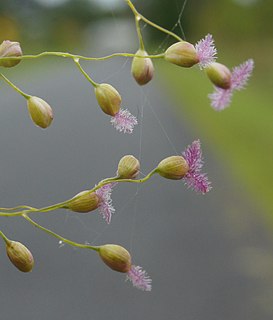
Panicoideae is the second-largest subfamily of the grasses with over 3,500 species, mainly distributed in warm temperate and tropical regions. It comprises some important agricultural crops, including sugarcane, maize, sorghum, and switchgrass.

Centotheceae is a small tribe of grasses with six species in two genera, distributed in Africa and Asia. It belongs to a basal lineage in subfamily Panicoideae, sometimes referred to as "centothecoid clade". Unlike many other clades in the subfamily Panicoideae, they use the C3 photosynthetic pathway.
Oplismenopsis is a genus of South American plants in the grass family. The only known species is Oplismenopsis najada, native to southern Brazil, Uruguay, and northeastern Argentina.
Lecomtella is a genus of grasses with the sole species Lecomtella madagascariensis, native to Madagascar. It is the only genus in the tribe Lecomtelleae.

The Stipeae are a tribe of grasses within the subfamily Pooidae, with up to 600 described species.

The BOP clade (sometimes BEP clade) is one of two major lineages (or clades) of undefined taxonomic rank in the grasses (Poaceae), containing more than 5,400 species, about half of all grasses. Its sister group is the PACMAD clade; contrary to many species of that group who have evolved C4 photosynthesis, the BOP grasses all use the C3 photosynthetic pathway.

The Aristideae is the sole tribe of grasses in the monotypic subfamily Aristidoideae of the true grass family Poaceae. Its members are herbaceous annuals or perennials found in the tropics, subtropics and temperate zones. The tribe has over 300 species in three genera: The subfamily is a member of the PACMAD clade of grasses, the evolutionary group in which C4 photosynthesis independently evolved a number of times.

The Puelioideae is a subfamily of the true grass family Poaceae with two genera, Guaduella and Puelia, each in its own tribe. Its members grow in the understory of rainforests.
Anomochlooideae is a subfamily of the true grass family Poaceae. It is sister to all the other grasses. It includes perennial herbs that grow on the shaded floor of forests in the Neotropics. There are two genera, Anomochloa and Streptochaeta, each in its own tribe.

The PACMAD clade (previously PACCMAD, PACCAD, or PACC) is one of two major lineages (or clades) of the true grasses (Poaceae), regrouping six subfamilies and about 5700 species, more than half of all true grasses. Its sister group is the BOP clade. The PACMAD lineage is the only group within the grasses in which the C4 photosynthesis pathway has evolved; studies have shown that this happened independently multiple times.

Paniceae is a large tribe of the subfamily Panicoideae in the grasses (Poaceae), the only in the monotypic supertribe Panicodae. It includes roughly 1,500 species in 84 genera, primarily found in tropical and subtropical regions of the world. Paniceae includes species using either of the C4 and C3 photosynthetic pathways, as well as presumably intermediate species. Most of the millets are members of tribe Paniceae.
Rupichloa is a genus of Brazilian plants in the grass family.
Canastra is a genus of bunchgrass plants in the grass family. Its species are endemic to Brazil.

Micrairoideae is a subfamily of the grass family Poaceae, distributed in tropical and subtropical regions. Within the PACMAD clade, it is sister to subfamily Arundinoideae.

Paspaleae is a tribe of the Panicoideae subfamily in the grasses (Poaceae), native mainly to the tropical and subtropical Americas but with a number of species introduced to other regions. It includes roughly 680 species in 39 genera. Species in this tribe use either of the C3 or C4 photosynthetic pathways.
Steyermarkochloeae is a tribe of the Panicoideae subfamily in the grasses (Poaceae), native to tropical South America. There are only two species in two genera, Arundoclaytonia and Steyermarkochloa. The tribe probably belongs to a basal lineage within the subfamily. Species in this tribe use the C3 photosynthetic pathway.

Tristachyideae is a tribe of the Panicoideae subfamily in the grasses (Poaceae), native to tropical and subtropical regions of Africa, Asia, and South America. There are around 70 species in eight genera. The tribe belongs to a basal lineage within the subfamily, and its genera were previously placed in tribes Arundinelleae or Paniceae, subfamily Arundinoideae, or the now-obsolete subfamily Centothecoideae. Species in this tribe use the C4 photosynthetic pathway.

Zeugiteae is a tribe of the subfamily Panicoideae in the grasses (Poaceae), native to Africa, Asia, Australasia, South and Central America. There are 18 species in four genera. The tribe belongs to a basal lineage within the subfamily. Species in this tribe use the C3 photosynthetic pathway.

Chasmanthieae is a small tribe of grasses in the subfamily Panicoideae. It belongs to a basal lineage within the subfamily and has only seven species in two genera, Bromuniola with one species in Africa and Chasmanthium from North America. They all use the C3 photosynthetic pathway.
Cyperochloeae is a small tribe of grasses in the Panicoideae subfamily, found in Australia. It belongs to a basal lineage within the subfamily and has only two species in two monotypic genera, Cyperochloa and Spartochloa. They use the C3 photosynthetic pathway.













